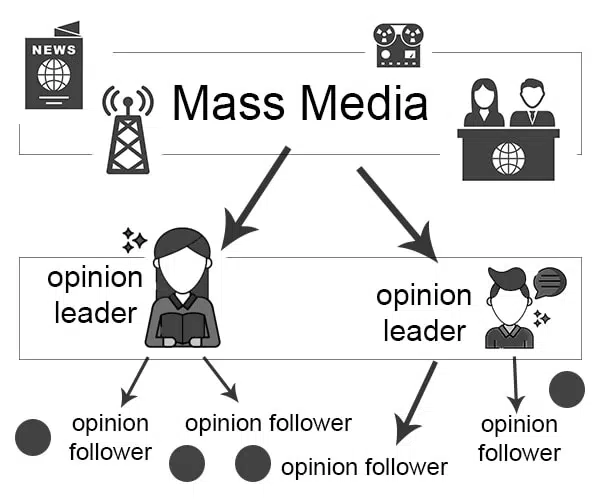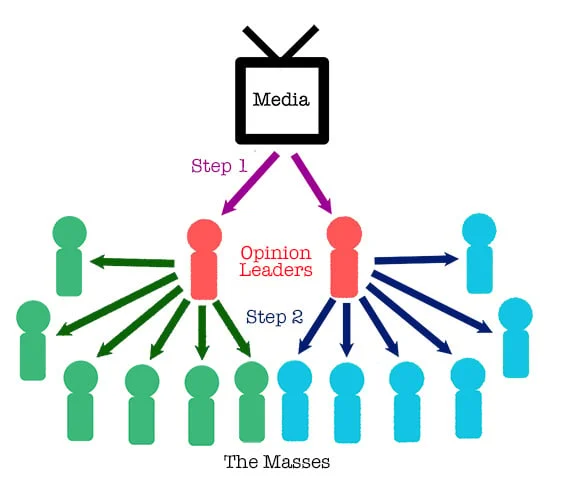Have you ever thought about where the messages we receive on social media truly come from, and who holds the power in shaping them? The answer is not as simple as it seems. Behind this everyday phenomenon lies a theory first proposed by Paul Lazarsfeld—the Two-Step Flow of Communication. This theory argues that we do not receive information directly from the media industry itself, but rather through our social relationships. In other words, ideas often reach us via more influential individuals who interpret and share them within their communities. These “opinion leaders” act as intermediaries, guiding how information spreads and how meaning is constructed in the social media environment.

According to Scannell (2007), early mass communication studies moved away from the assumption of a powerful, one-directional media influence. Lazarsfeld’s research demonstrated that media effects were “limited”: rather than directly shaping audience opinions, the media’s influence was filtered through social interactions. Messages travel first to opinion leaders, who then pass them on to wider audiences. Within this process, opinion leaders play an active role in interpreting media content, while recipients often remain passive followers. Thus, the Two-Step Flow model highlights the social nature of media influence and the uneven distribution of communicative power.
The same pattern is visible on various platforms such as TikTok and Rednote (Xiaohongshu). When a beauty influencer recommends a particular product, followers not only trust her opinion but often share and reproduce the same message within their own networks. For instance, when a beauty brand hires an influencer on Rednote to promote a new product, consumers may accept her endorsement without verifying the actual quality or story behind the brand. This example supports Lazarsfeld’s theory of the “Two-Step Flow,” as Scannell’s discussion of the social mediation of media influence remains highly relevant to this digital form of communication.

However, as Scannell (2007) notes, Lazarsfeld’s colleague Robert Merton warned of the ‘narcotizing dysfunction’ of media audiences. Even when individuals feel informed, the information may be fragmented or illogical, leading them to become passive consumers of mediated influence. Reflecting on the “Two-Step Flow” theory helps us understand the process by which audiences receive information and the underlying power dynamics. While the theory is useful in analyzing today’s social media landscape, it has limitations. Influencers can both broaden communication through social interaction and amplify commercial interests, raising questions about the balance of influence and control. Therefore, when engaging with social media, we should verify sources and judge carefully rather than being led astray by a single “leader.”
Nevertheless, the Two-Step Flow remains a valuable framework for understanding influence in the age of social media. As Scannell (2007) emphasizes, communication has always been social, and even the newest technologies continue to rely on human intermediaries to shape what we see, believe, and share. This reminds us that even in a highly digitalized world, human judgment and critical thinking remain essential in navigating mediated influence.
Reference:
Scannell, Paddy. ‘Chapter 1: Mass Communication: Lazarsfeld, Adorno, Merton, USA, 1930s and 1940s’. Media and Communication, by Paddy Scannell, SAGE, 2007, pp. 9–30, https://doi.org/10.4135/9781446211847.n2.
image from https://share.google/images/Vrow085NDfAwo5tDN
https://share.google/images/Vrow085NDfAwo5tDN


This is a very clear and well-structured discussion of the Two-Step Flow Theory. I particularly like how you connect classical communication theories from Lazarsfeld and Merton to modern platforms like TikTok and Rednote. You also do a good job of emphasizing that while technology changes, the social and psychological dynamics of influence remain deeply human. You can enrich your content that discusses the vague boundary between “opinion leaders” and “ordinary users.”
It was interesting to read your explanation on how audiences have become passive in response to waiting for their ‘intermediaries’ to relay and reiterate information to them. It begs the question as to whether audiences are really engaging with content at all?
Thank you so much for commenting on my blog! The question you raised was really insightful. I think the answer largely depends on both the opinion leaders and the audiences who receive the information. Those with stronger critical thinking skills—often well-educated individuals, like us media students—tend to evaluate messages more carefully. In contrast, some people might accept whatever the opinion leader says without much questioning.
Additionally, the tone of the opinion leader plays an essential role. If they express their ideas in a logical and persuasive way, audiences may be more likely to believe them and even develop a stronger connection. It also depends on factors like how long people have been using social media and how carefully they read blogs or articles online. Therefore, exploring and reflecting on this topic is crucial for understanding media influence in today’s society.
This is such an interesting take on the Two Step Flow theory. I like how you linked it to TikTok and Rednote, it honestly fits so well with how influencers shape what people buy or believe now. The part about “opinion leaders” really stands out, because it’s true that most of us don’t get our information directly from media anymore, but from people we already trust online. I also liked that you mentioned Merton’s ‘narcotizing dysfunction’ it’s scary how easy it is to feel informed just by scrolling without actually thinking critically. It made me realise how much control influencers and algorithms have in shaping what we see.
Your writing is very clear and insightful, and it also connects classic theories with contemporary theoretical fields. I particularly find your point that although the audience seems to receive information “directly” on social platforms, they are still within a mediated network “through trusted intermediaries” very valuable for understanding the communication logic in the era of social media. You also mentioned at the end of the article that influencer communication, while expanding interaction, may also strengthen commercial interests and weaken the audience’s critical awareness. This reminds us that “mediatization of society + interpersonal mediation” is not simply liberating but comes with new control mechanisms. This is excellent. I look forward to your further exploration in the next article!